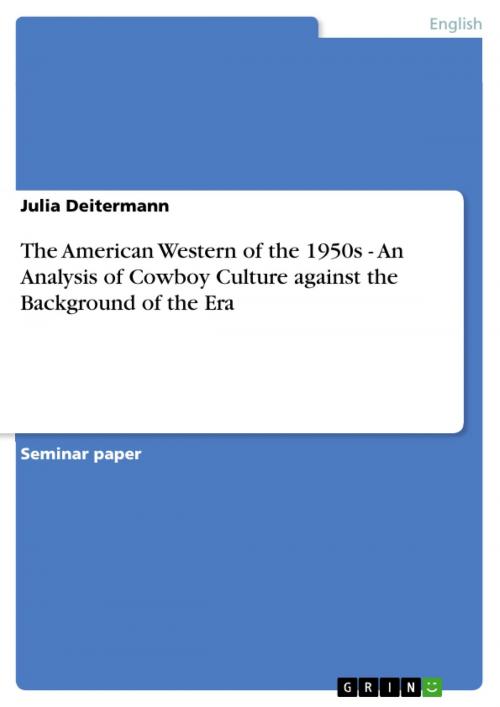The American Western of the 1950s - An Analysis of Cowboy Culture against the Background of the Era
An Analysis of Cowboy Culture against the Background of the Era
Nonfiction, Entertainment, Drama, Anthologies| Author: | Julia Deitermann | ISBN: | 9783638546294 |
| Publisher: | GRIN Verlag | Publication: | September 18, 2006 |
| Imprint: | GRIN Verlag | Language: | English |
| Author: | Julia Deitermann |
| ISBN: | 9783638546294 |
| Publisher: | GRIN Verlag |
| Publication: | September 18, 2006 |
| Imprint: | GRIN Verlag |
| Language: | English |
Seminar paper from the year 2004 in the subject American Studies - Culture and Applied Geography, grade: A, San Diego State University, course: Modern American Literature and Culture, 11 entries in the bibliography, language: English, abstract: Broncho Billy, Billy the Kid, Buffalo Bill - there hardly seems to be anyone in the world who has never heard about the heroes of American Western culture. Nowadays, cowboys are considered to be the embodiment of freedom and independence. Whereas cowboys have existed for hundreds of years, however, their image has changed over the centuries. In the 18thand 19thcentury, 'cow boys' were considered bad guys as they were bandits who remorselessly ambushed colonial farmers. It was not until the period after the Civil War that the word cowboy attained a positive connotation, being associated with rough men on horses who herded cattle. In the course of time, the cowboy figure was glorified and became a symbol of the American spirit. A plague in the Buffalo Bill Historical Center in Wyoming summarizes the glorification as it reads: 'The cowboy is a mythic character in America. We admire him for his independence, his honesty, his modesty and courage. He represents the best in all Americans as he stares down evil and says, 'When you call me that, smile'.' When the motion picture was invented at the end of the 19th century, some of the first silent movies were documentations about cowboys, embodying the frontier spirit of the American culture, which has always been connected to the westward expansion of civilisation and the conquest of new unknown territories. Thus both the frontier and 'the Western oppose[s] Wilderness to Civilization' as Will Wright puts it in his book Six Guns and Society. Edwin Porter's The Great Train Robberycame to be the first Western narrating a story and fascinated the audience. In the following years, Western movies were most popular among the audience and were consequently produced in large numbers. Still today, they rank among the most beloved movie genres. Although the movie genre Western did not always stay at the peak of success, however, the boom was revived on a large scale in the 1950s. In this paper, I will try to reveal the fascination implicated in Western movies and analyse the figure of the cowboy against the background of the 1950s. In doing so, I will include the investigation of gender roles and the effects Westerns had on society. Casually, I will also draw on the popular TV Western series Gunsmoke which ought to serve as a demonstrative example. As far as the movie genre Western is concerned, the era of the 1950s was shaped by radical changes. [...]
Seminar paper from the year 2004 in the subject American Studies - Culture and Applied Geography, grade: A, San Diego State University, course: Modern American Literature and Culture, 11 entries in the bibliography, language: English, abstract: Broncho Billy, Billy the Kid, Buffalo Bill - there hardly seems to be anyone in the world who has never heard about the heroes of American Western culture. Nowadays, cowboys are considered to be the embodiment of freedom and independence. Whereas cowboys have existed for hundreds of years, however, their image has changed over the centuries. In the 18thand 19thcentury, 'cow boys' were considered bad guys as they were bandits who remorselessly ambushed colonial farmers. It was not until the period after the Civil War that the word cowboy attained a positive connotation, being associated with rough men on horses who herded cattle. In the course of time, the cowboy figure was glorified and became a symbol of the American spirit. A plague in the Buffalo Bill Historical Center in Wyoming summarizes the glorification as it reads: 'The cowboy is a mythic character in America. We admire him for his independence, his honesty, his modesty and courage. He represents the best in all Americans as he stares down evil and says, 'When you call me that, smile'.' When the motion picture was invented at the end of the 19th century, some of the first silent movies were documentations about cowboys, embodying the frontier spirit of the American culture, which has always been connected to the westward expansion of civilisation and the conquest of new unknown territories. Thus both the frontier and 'the Western oppose[s] Wilderness to Civilization' as Will Wright puts it in his book Six Guns and Society. Edwin Porter's The Great Train Robberycame to be the first Western narrating a story and fascinated the audience. In the following years, Western movies were most popular among the audience and were consequently produced in large numbers. Still today, they rank among the most beloved movie genres. Although the movie genre Western did not always stay at the peak of success, however, the boom was revived on a large scale in the 1950s. In this paper, I will try to reveal the fascination implicated in Western movies and analyse the figure of the cowboy against the background of the 1950s. In doing so, I will include the investigation of gender roles and the effects Westerns had on society. Casually, I will also draw on the popular TV Western series Gunsmoke which ought to serve as a demonstrative example. As far as the movie genre Western is concerned, the era of the 1950s was shaped by radical changes. [...]















